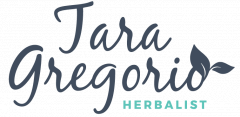How To Use Herbs While Breastfeeding Without Fear - 4 Simple Steps
Are you wondering how you can use natural remedies while nursing without worry?In this post, I'll cover the four simple steps you can take to use herbal medicine without fear during the nursing years.But don't forget, always check with your doctor before taking herbal medicine.
So, what's the secret? Here are the four steps...
#1 Do you have any allergies?
If you or your child’s father has a known allergy, stay away from these botanicals.
For example… Chamomile is the safest herb to take while breastfeeding, BUT if you have an allergy to the daisy or Asteraceae family avoid this botanical and the other herbs in its family altogether.
#2 Are you taking medications?
If you're taking medication, you always want to check with your doctor before adding in botanicals.
For example, if you're taking SSRIs, the biggest herb/drug interaction may be St. John's Wort.
You would never want to take a botanical for which you are already taking conventional medication.
#3 Botanicals to avoid while nursing
There are botanicals you may want to avoid while nursing. Keep in mind, this is not a complete list but it will help you feel a bit more comfortable.
Some of the herbs on the list are not safe to take internally, but you may see they are suggested externally; like comfrey root for cracked nipples.
And, some of the herbs like Lemon Balm - will not hurt your child, but will affect the taste of the milk.
And lastly, some women have taken St. John's Wort for postpartum depression; even though it is a Level 2/3 botanical.
For a complete list of herbs to avoid, DOWNLOAD this PDF
Moms love Kellymom.com as a resource to check botanicals while breastfeeding
Herbs to Avoid While Breastfeeding
Watch this video for a complete review of this post
#4 What is safe?
Safe natural remedies while nursing
A) First, you want to know what is the lactation risk.
It's categorized into 5 levels by the German Commission E.
LACTATION RISK CATEGORIES
Best Diet for Nursing Moms
•L1 Safest - No adverse effect observed in infants of lactating mothers
•L2 Safer - Limited studies demonstrate no increased risk
•L3 Moderately Safe - No controlled studies in breastfeeding women or controlled studiesdemonstrate minimal adverse effects
•L4 Possible Risk - Positive evidence of risk but benefits may make the risk acceptable
•L5 Contraindicated - Significant documented risk.
The safest thing to do is try one herb at a time and wait and see.
B) Then you want to look for adverse reactions.
What are adverse reactions?
any changes in your child's skin color
any allergic reactions
if they fall asleep - when it's not nap time. This has happened with valerian root.
if they're fussy, colicky, or unusually uncomfortable
If this happens, stop taking the botanical and wait.
Typically, when you're child is three months or older their liver is able to process all medications and it's a safe time to introduce Level 1 botanicals.
In a nutshell, you'll want to know which herbs are safe to take internally versus externally and the lactation risk categories determined by studies. {pubmed is a good source}
I'm often asked what books I love...
Books for breastfeeding safety
American Herbal Products Associations; Botanical Safety Handbook
Hales; Medications and Mother’s Milk: https://amzn.to/35XZFq5- more about conventional medication and nursing
Bone & Mills: Principles and Practice of Phytotherapy
Aviva Romm: Botanical Medicine of Women’s Health- Categories from the German Commission E. {see below}
Brinker, Francis: Herbal Contraindications and drug interactions
Conclusion
Herbal medicine is a great additive during the breastfeeding years when you know which botanicals to use. Start with teas, then try a tincture or an external lotion or salve to help soothe you. Learn the risks of each herbal botanical and try one herb at a time.Keep in mind, homeopathy is safest - although harder to match with remedies. With time, I hope you grow to love herbal medicine as much as I do.Have quesitons? Check out my youtube channel other blog posts or comment below.
xo Tara
Here are some articles to check out

